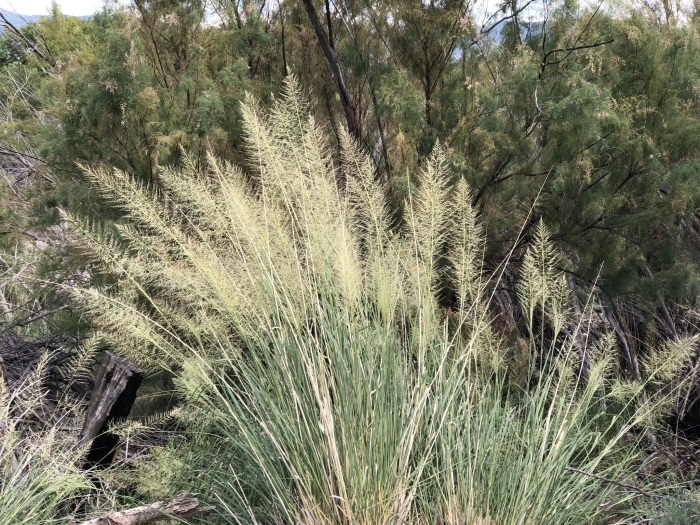Big Sacaton
(Sporobolus wrightii)
Big Sacaton (Sporobolus wrightii)
/
/

CK Kelly
CC BY 4.0
Image By:
CK Kelly
Recorded By:
Copyright:
CC BY 4.0
Copyright Notice:
Photo by: CK Kelly | License Type: CC BY 4.0 | License URL: http://creativecommons.org/licenses/by/4.0/ | Rights Holder: CK Kelly | Publisher: iNaturalist | Date Created: 2018-08-26T20:38:22Z |



















































Estimated Native Range
Summary
Sporobolus wrightii, commonly known as Big Sacaton, is a perennial bunchgrass that is deciduous or semi-deciduous, native to arid grasslands, savannas, and desert scrub regions of the Southwestern USA, particularly in Arizona, New Mexico, Texas, and northern Mexico. It can reach a height of up to 2.5 meters with robust, thick stems, and bears long leaves ranging from 20 to 70 centimeters. The inflorescence is a lance-shaped panicle, up to 60 centimeters long, with purplish or greenish spikelets that appear in late summer to fall. The flowers are not particularly showy but add a fine texture to the landscape.
Big Sacaton is valued for its adaptability to harsh environments, making it an excellent choice for naturalistic plantings, erosion control, and habitat restoration projects. It thrives in full sun and is tolerant of a range of soil drainage conditions, from slow to fast. This grass is also fire-resistant and can be used in fire-prone areas as a firebreak. In cultivation, it requires medium amounts of water, making it suitable for xeriscaping. While generally low-maintenance, it can be susceptible to rust diseases under certain conditions.CC BY-SA 4.0
Big Sacaton is valued for its adaptability to harsh environments, making it an excellent choice for naturalistic plantings, erosion control, and habitat restoration projects. It thrives in full sun and is tolerant of a range of soil drainage conditions, from slow to fast. This grass is also fire-resistant and can be used in fire-prone areas as a firebreak. In cultivation, it requires medium amounts of water, making it suitable for xeriscaping. While generally low-maintenance, it can be susceptible to rust diseases under certain conditions.CC BY-SA 4.0
Plant Description
- Plant Type: Grass
- Height: 3-7 feet
- Width: 2-4 feet
- Growth Rate: Moderate
- Flower Color: N/A
- Flowering Season: Summer
- Leaf Retention: Deciduous
Growth Requirements
- Sun: Full Sun
- Water: Medium
- Drainage: Slow, Medium, Fast
Common Uses
Bank Stabilization, Bird Garden, Deer Resistant, Drought Tolerant, Erosion Control, Fire Resistant, Fragrant, Groundcover, Low Maintenance, Rabbit Resistant, Salt Tolerant, Street Planting, Water Garden
Natural Habitat
Native to arid grasslands, savannas, and desert scrub regions of the Southwestern USA
Other Names
Common Names: Big Alkali Sacaton, Sacaton, Giant Sacaton
Scientific Names: , Sporobolus wrightii, Sporobolus airoides var. wrightii, Sporobolus eminens, Epicampes crassiculmis, Bauchea karwinskyi, Sporobolus altissimus, Sporobolus expansus, Sporobolus schaffneri, Sporobolus altissimus var. minor
GBIF Accepted Name: Sporobolus wrightii Scribn.